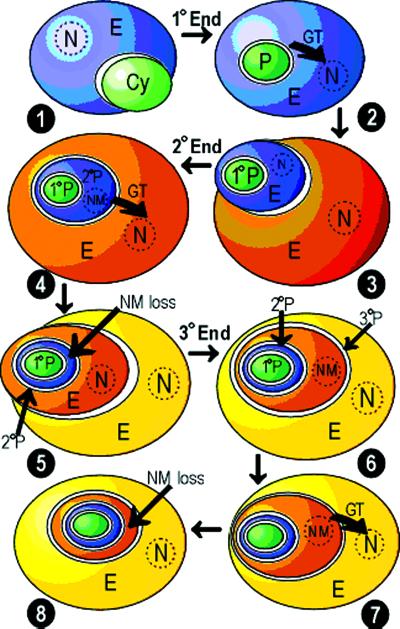Figure 1.
Theoretical steps of primary, secondary, and tertiary plastid endosymbiosis. (1) A nonphotosynthetic eukaryote engulfs a cyanobacterium. (2) The engulfed cyanobacterium becomes the cell's plastid, and gene transfer occurs between the cyanobacterium cell and the host cell nucleus. The cyanobacterial membrane becomes the inner plastid membrane and the eukaryotic vacuolar membrane becomes the outer plastid membrane (primary endosymbiosis). (3) A nonphotosynthetic eukaryote engulfs a eukaryote with a primary plastid. (4) Four plastid membranes are present from the primary and secondary plastids (see text); the nucleus of the secondary plastid is reduced to a nucleomorph (which is present in the chlorarachniophytes and the cryptophyes); gene transfer occurs between the nucleomorph of the secondary plastid and the nucleus of the host cell (secondary endosymbiosis). (5) A eukaryotic cell with a secondary plastid is engulfed by a nonphotosynthetic eukaryote (tertiary endosymbiosis). The remnant nucleomorph of the secondary plastid is lost. (6) Up to six plastid membranes are theoretically possible (see text). The nucleus of the engulfed cell has been reduced to a nucleomorph. (7) Gene transfer occurs between the nucleomorph of the tertiary plastid and the host cell nucleus. (8) The nucleomorph of the tertiary plastid is lost. Abbreviations: 1° End, primary endosymbiosis; 2° End, secondary endosymbiosis; 3° End, tertiary endosymbiosis; Cy, cyanobacterium; E, eukaryote; GT, gene transfer; N, nucleus; NM, nucleomorph; P, plastid.

